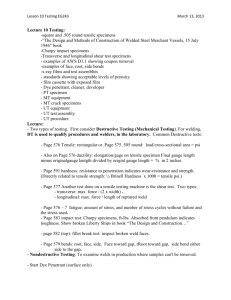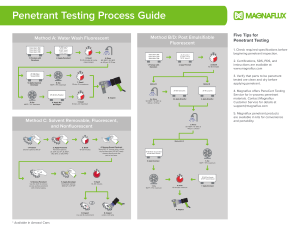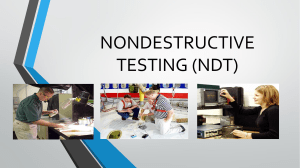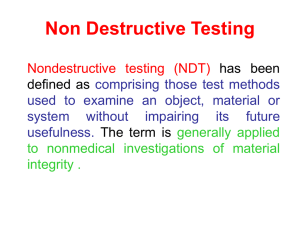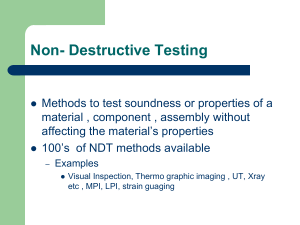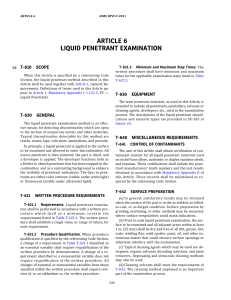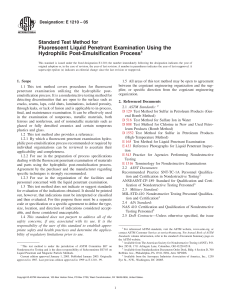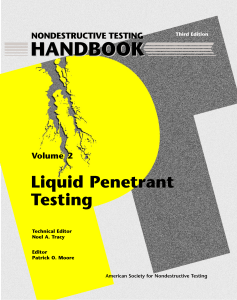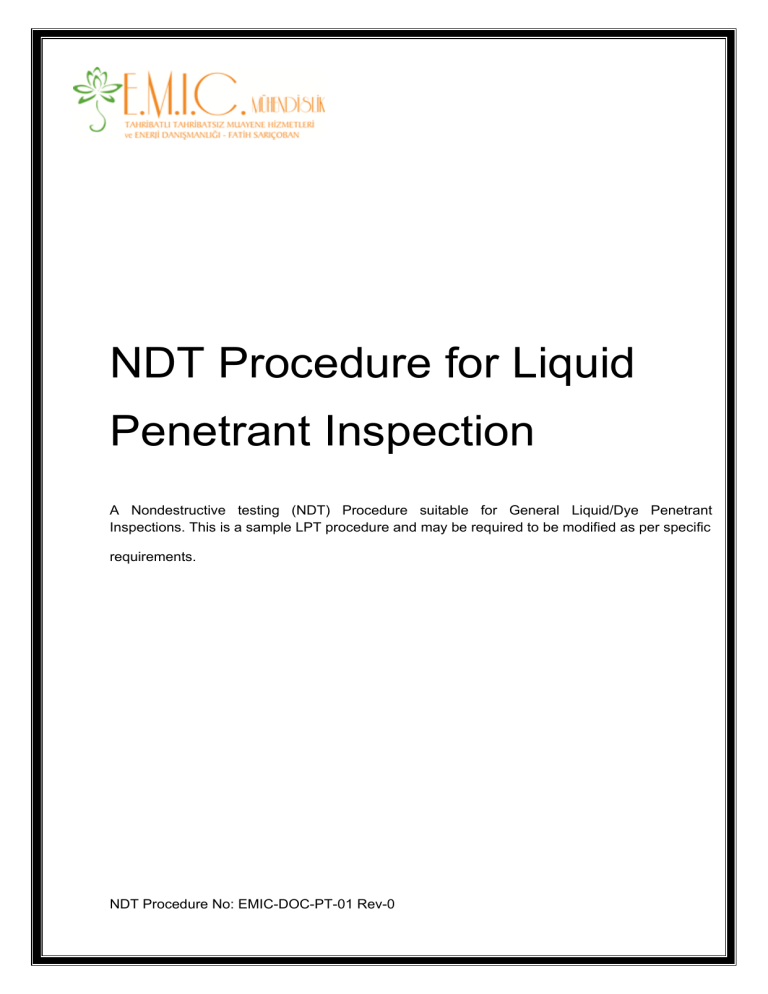
NDT Procedure for Liquid Penetrant Inspection A Nondestructive testing (NDT) Procedure suitable for General Liquid/Dye Penetrant Inspections. This is a sample LPT procedure and may be required to be modified as per specific requirements. NDT Procedure No: EMIC-DOC-PT-01 Rev-0 1. Scope This Test method covers procedures for penetrant examination of butt and fillet weld with the associated Heat Effected Zone (HAZ) on the parent metal and components. They are non-destructive testing methods for detecting discontinuities that are open to the surface such as cracks, porosity and lack of fusion by liquid penetrant testing conducted in accordance with the requirements of the referenced Codes and Standards. 2. Purpose The purpose of this procedure is to explain the method of applying the liquid penetration nondestructive test. 3. References 1.1. ASME Code Section V -applicable edition/addenda. 1.2. ASME Code Section I -applicable edition/addenda. 1.3. ASME Code Section VIII, Div1-applicable edition/addenda. 1.4. ANSI/ASME B31.1, B31.3 applicable edition/addenda. 1.5. AWS D1.1 - applicable edition. 1.6. ASTM-E165-Standard Test Method for Liquid Penetrant Examination. 1.7. Clients specification requirements for acceptance criteria. 1.8. EMIC Written Practice Note: In case of conflict between Code requirements and Client’s specifications, Code requirements shall prevail. 4. Definitions PT : Penetrant Examination 5. Responsibilities The NDT Inspector shall be responsible for conducting and reporting the results of inspection in accordance with project contract. 6. Personnel Qualifications 6.1 All personnel involved in Penetrant Examinations shall be qualified in accordance with the Requirements of EMIC Written Practice for NDE Personnel Qualification. 6.2 When the written practice is revised, the certification of NDE personnel remains valid to the requirements of the previous revision until the expiry date of the personnel qualification certificate; then, recertification to the requirements of the new revision is required. 6.3 The certification of personnel shall be checked by the QA/QC Manager prior to work commencement. 7. Procedure This procedure shall be demonstrated prior to use in accordance with the requirements of T150, ASME Code Sec. V. The procedure qualification record shall be attached to this procedure. 7.1 Equipment: 7.1.1 Solvent Removable Visible Dye Penetrant materials consist of: a) Penetrant. b) Penetrant remover/cleaner. c) Developer. d) Lint free cloth. e) Light meter capable of measuring visible light intensity in lux / foot candles (f.c.). The light meter shall meet the calibration requirement of T-660 of ASME Code Section V 7.2 Materials: 7.2.1 Only materials of a recognized commercial quality shall be used as identified by the manufacturer’s name i.e. Ardrox, Beta or Magnaflux or as specified by the client. 7.2.2 Penetrant materials of the same family group shall be used, mix between family groups is prohibited. 7.2.3 Certification of contaminant content shall be provided by manufacturers for all liquid penetrant materials used on nickel base alloys, austenitic or duplex stainless steels, and titanium. These certifications shall include the penetrant manufacturers' batch numbers and the test results obtained in accordance with Mandatory Appendix II of Article 6, ASME Code Sec. V. These records shall be maintained as required by the referencing Code Section. 7.3 Surface Condition: 7.3.1 Generally satisfactory results may be obtained when the surface of the part is in the aswelded, as-rolled, as-cast, or as forged condition. Surface preparation by grinding, machining, or other methods may be necessary where surface irregularities could mask indications of unacceptable discontinuities. Precautions shall be made with the mechanical cleaning not to close the discontinuities open to the surface. Etching of the cleaned surfaces may be necessary to open the discontinuities. 7.3.2 Prior to all liquid penetrant inspections, the surface to be examined and all adjacent areas within at least 25mm (1”) shall be dry and free of dirt, grease, lint, scale, welding flux, weld spatter, oil and other extraneous matters that could obscure surface openings or otherwise interfere with the examination. 7.3.3 Typical cleaning agents that may be used are detergents, organic solvents, descaling solutions and paint removers. Degreasing and ultrasonic cleaning methods may also be used. 7.4 Method: 7.4.1 Surface Cleaning process: a) Solvent cleaning method: On removal of any rust, scale, welding flux, spatter, and in general, inorganic soils, the surfaces to be inspected shall be cleaned, with solvent cleaner and then finally with a dry lint free cloth. 7.4.2 Drying Process: a) The drying process shall be accomplished by normal evaporation. Minimum time allowed for drying is 1 minute to ensure that the cleaning solution has been evaporated prior to application of the penetrant. 7.4.3 Application of penetrant: a) After the area has been cleaned, dried and the temperature of the surface and penetrant are within the range of 40° F (5° C) to 125° F (52° C), the penetrant shall be sprayed directly to the surface to be inspected by means of aerosol container, so that the entire area under inspection is completely covered. b) After application, excess penetrant shall be allowed to drain (care being taken to prevent pools of penetrant forming on the test area) while allowing for minimum penetration (dwell) time stated in accordance with (ASME V.Article24, SE165) unless otherwise specified by the client in a more restrictive manner. c) The length of time the penetrant must remain on the part to allow proper penetration should be as recommended by the penetrant manufacturer (dwell time shall not exceed the maximum recommended by the manufacturer). 7.4.4 Excess Penetrant removal: a) After the specified dwell time has been elapsed, any penetrant remaining on the surface shall be removed with a dry or slightly moistened cloth of solvent cleaner, taking care to minimize removal of penetrant from possible discontinuity. b) Flushing the surface with solvent cleaner, following the application of the penetrant and prior to developing is prohibited. 7.4.5 Drying after removal of excess penetrant: a) The drying process shall be accomplished by normal evaporation. Drying time shall only be that necessary to adequately dry the part. 7.4.6 Application of the developer: a) Apply the non-aqueous wet developer directly to the area being inspected, by spraying from the aerosol container. b) The non-aqueous developer evaporates rapidly at room temperature and therefore does not require the use of a dryer. c) Areas being inspected shall be sprayed in such a manner so as to assure complete coverage with a thin, even film of developer. d) Dipping or flooding parts with non-aqueous developer is prohibited. e) Developing dwell time shall not be less than 10 min., The maximum permitted developing time is 1 h for nonaqueous developers as stated in accordance with (ASME-V.Article24, SE165) unless otherwise specified by the client, in a more restrictive manner. 7.5 Examination: 7.5.1 Inspection shall be carried out after the applicable developer dwell time to allow for bleed out of penetrant from discontinuities into the developer coating. It is good practice to observe the bleed out while applying the developer as an aid in interpreting and evaluating indications. 7.5.2 Visible penetrant indications can be inspected in natural or artificial white light. A minimum intensity at the inspection surface of 100 foot candles (1000 Lux) is required. 7.5.3 The light source, technique used, and light level verification is required to be demonstrated, one time, documented, and maintained on file. 7.6 Evaluation of indications: 7.6.1 All indications shall be evaluated in accordance with the referencing code or Specification. 7.6.2 Relevant indications are those that result from mechanical discontinuities: a) Linear indications are those indications in which the length is more than three times the width. b) Rounded indication or indications which are circular or elliptical with lengths less than three times the width. c) Any questionable or doubtful indications shall be re-tested to verify whether or not actual defects are present. d) Localized surface imperfections may occur, such as machine marks, surface conditions, or incomplete bond between base metal and cladding, may produce similar indications which are not relevant to the detection of unacceptable discontinuities. 7.7 Acceptance Criteria: 7.7.1 Acceptance criteria for specific Codes are listed as below. 7.8 Post cleaning: 7.8.1 Upon completion of the test, in cases where residual penetrant or developer could interfere with subsequent processing or with service requirements, a suitable technique, such as a water rinse or solvent soak for cleaning may be employed. 7.9 Documentation: 7.9.1 Non-rejectable indications shall be recorded as specified by the referencing Code Section. 7.9.2 Rejectable indications shall be recorded. As a minimum, the type of indications (linear or rounded), location and extent (length or diameter or aligned) shall be recorded. 8. Records Liquid Penetrant Examination shall be documented on Liquid Penetrant Examination Report form no. EMIC-PT-01 Rev ‘0’ 9. Attachments: Liquid Penetrant Examination Report ………………………………………..EMIC-PT-01 Rev ‘0’
